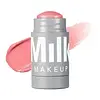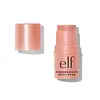What's inside
What's inside
 Key Ingredients
Key Ingredients

 Benefits
Benefits

No benefits
 Concerns
Concerns

 Ingredients Side-by-side
Ingredients Side-by-side

Ricinus Communis Seed Oil
MaskingPersea Gratissima Oil
Skin ConditioningEthylhexyl Palmitate
EmollientHelianthus Annuus Seed Wax
Skin ConditioningCandelilla Cera
EmollientC12-15 Alkyl Benzoate
AntimicrobialIsononyl Isononanoate
EmollientSilica
AbrasiveParfum
MaskingCitrus Aurantium Dulcis Peel Wax
Skin ConditioningMangifera Indica Seed Butter
Skin ConditioningPrunus Armeniaca Kernel Oil
MaskingTocopheryl Acetate
AntioxidantHydrogenated Vegetable Oil
EmollientMica
Cosmetic ColorantStearalkonium Hectorite
Gel FormingIsopropyl Myristate
EmollientPolyhydroxystearic Acid
EmulsifyingBis-Stearyl Dimethicone
EmollientIsopropyl Titanium Triisostearate
EmollientSynthetic Fluorphlogopite
Tin Oxide
AbrasivePalmitic Acid
EmollientLimonene
PerfumingLinalool
PerfumingCI 77891
Cosmetic ColorantCI 77492
Cosmetic ColorantCI 15850
Cosmetic ColorantCI 73360
Cosmetic ColorantCI 19140
Cosmetic ColorantRicinus Communis Seed Oil, Persea Gratissima Oil, Ethylhexyl Palmitate, Helianthus Annuus Seed Wax, Candelilla Cera, C12-15 Alkyl Benzoate, Isononyl Isononanoate, Silica, Parfum, Citrus Aurantium Dulcis Peel Wax, Mangifera Indica Seed Butter, Prunus Armeniaca Kernel Oil, Tocopheryl Acetate, Hydrogenated Vegetable Oil, Mica, Stearalkonium Hectorite, Isopropyl Myristate, Polyhydroxystearic Acid, Bis-Stearyl Dimethicone, Isopropyl Titanium Triisostearate, Synthetic Fluorphlogopite, Tin Oxide, Palmitic Acid, Limonene, Linalool, CI 77891, CI 77492, CI 15850, CI 73360, CI 19140
Silica
AbrasiveTriethylhexanoin
MaskingDimethicone
EmollientSynthetic Fluorphlogopite
Cetyl Ethylhexanoate
EmollientHydrogenated Polydecene
EmollientSynthetic Wax
AbrasiveIsononyl Isononanoate
EmollientMica
Cosmetic ColorantMicrocrystalline Wax
Emulsion StabilisingSorbitan Sesquiisostearate
EmulsifyingCaprylyl Glycol
EmollientTin Oxide
AbrasiveTocopheryl Acetate
AntioxidantCaesalpinia Sappan Bark Extract
Skin ConditioningCI 77891
Cosmetic ColorantCI 77491
Cosmetic ColorantBlue 1 Lake
Cosmetic ColorantSilica, Triethylhexanoin, Dimethicone, Synthetic Fluorphlogopite, Cetyl Ethylhexanoate, Hydrogenated Polydecene, Synthetic Wax, Isononyl Isononanoate, Mica, Microcrystalline Wax, Sorbitan Sesquiisostearate, Caprylyl Glycol, Tin Oxide, Tocopheryl Acetate, Caesalpinia Sappan Bark Extract, CI 77891, CI 77491, Blue 1 Lake
Ingredients Explained
These ingredients are found in both products.
Ingredients higher up in an ingredient list are typically present in a larger amount.
Ci 77891 is a white pigment from Titanium dioxide. It is naturally found in minerals such as rutile and ilmenite.
It's main function is to add a white color to cosmetics. It can also be mixed with other colors to create different shades.
Ci 77891 is commonly found in sunscreens due to its ability to block UV rays.
Learn more about CI 77891Isononyl Isononanoate is a synthetic skin-conditioner and texture enhancer. It is created from nonanoic acid, a fatty acid found in cocoa and lavender oil.
As an emollient, Isononyl Isononanoate helps keep your skin soft and smooth. This is because emollients create a barrier on the skin to trap moisture in.
Isononyl Isononanoate helps give products a velvet feel and improves spreadability.
Learn more about Isononyl IsononanoateMica is a naturally occurring mineral used to add shimmer and color in cosmetics. It can also help improve the texture of a product or give it an opaque, white/silver color.
Serecite is the name for very fine but ragged grains of mica.
This ingredient is often coated with metal oxides like titanium dioxide. Trace amounts of heavy metals may be found in mica, but these metals are not harmful in our personal products.
Mica has been used since prehistoric times throughout the world. Ancient Egyptian, Indian, Greek, Roman, Aztec, and Chinese civilizations have used mica.
Learn more about MicaSilica, also known as silicon dioxide, is a naturally occurring mineral. It is used as a fine, spherical, and porous powder in cosmetics.
Though it has exfoliant properties, the function of silica varies depending on the product.
The unique structure of silica enhances the spreadability and adds smoothness, making it a great texture enhancer.
It is also used as an active carrier, emulsifier, and mattifier due to its ability to absorb excess oil.
In some products, tiny microneedles called spicules are made from silica or hydrolyzed sponge. When you rub them in, they lightly polish away dead skin layers and enhance the penetration of active ingredients.
Learn more about SilicaSynthetic Fluorphlogopite is the synthethic version of mica. It consists of fluorine, aluminum and silicate.
Synthetic Fluorphlogopite is used to add volume to products.
It is considered non-irritating on the skin.
Learn more about Synthetic FluorphlogopiteTin Oxide is an inorganic oxide used to add opacity and volume to a product. In nature, it is already found in mineral form. The main ore of tin is an opaque and shiny mineral called casseterite.
Tin Oxide helps remove translucency in a product, or make it more opaque. Besides adding opacity, tin oxide is used for bulking to add volume.
Tocopheryl Acetate is AKA Vitamin E. It is an antioxidant and protects your skin from free radicals. Free radicals damage the skin by breaking down collagen.
One study found using Tocopheryl Acetate with Vitamin C decreased the number of sunburned cells.
Tocopheryl Acetate is commonly found in both skincare and dietary supplements.
Learn more about Tocopheryl Acetate